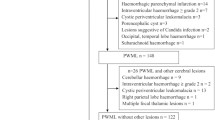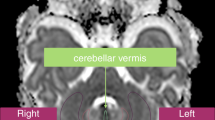Abstract
Our purpose was to measure the size of the pons and cerebellum in preterm babies with periventricular leukomalacia (PVL), and to study their relationship with the severity of PVL and with perinatal risk factors. We examined 33 premature children, mean gestational age 31 weeks, range 26–36 weeks with PVL on MRI, and 27 full-term controls. On MRI at 0.4–5.5 years (mean 1.4 years) we measured the area of the corpus callosum and vermis, the anteroposterior diameter of the pons and the volume of the cerebellum. The area of the corpus callosum was used as a marker of white matter loss and PVL severity. All regional brain measurements except that of the vermis were significantly lower in patients than controls: corpus callosum (mm2): 239.6±92.5 vs 434.8±126.8, P <0.01; pons (mm): 14.8±3.0 vs 17.9±1.4, P <0.01]; cerebellum (cm3): 68.2±31.6 vs 100.6±28.3, P <0.01; vermis (mm2): 808.1±292.2 vs 942.2±246.2, NS. Significant reduction in the area of the vermis: 411.3±203.3 vs 935±252.6 mm2; cerebellar volume: 16.3±12.5 vs 96.6±20.2 mm3; and the diameter of the pons: 10.1±2.2 vs 17.5±1.3 mm (P <0.01) were observed in seven children with gestational age ≤28 weeks, severe hypotension and large patent ductus arteriosus (PDA). There was a significant correlation between the duration of mechanical ventilation and the size of the vermis, pons and cerebellum (R=−0.65, −0.57 and −0.73, respectively, P <0.01).


Similar content being viewed by others
References
Volpe JJ (2001) Neurobiology of periventricular leukomalacia in the premature infant. Pediatr Res 50: 553–562
De Vries LS (1996) Neurological assessment of the preterm infant. Acta Paediatr 85: 765–766
Koeda T, Takeshita K (1992) Visuo-perceptual impairment and cerebral lesions in spastic diplegia with preterm birth. Brain Dev 14: 239–244
Jacobson L, Ek U, Fernell E, Flodmark O, Broberger U (1996) Visual impairment in preterm children with periventricular leukomalacia-visual, cognitive and neuropaediatric characteristics related to cerebral imaging. Dev Med Child Neurol 38: 724–736
Hadders-Algra M, Huisjes HJ, Touwen BC (1988) Perinatal risk factors and minor neurological dysfunction: significance for behavior and school achievement at nine years. Dev Med Child Neurol 30: 482–491
Snider LM (1998) Preschool performance skills of extremely low-birthweight children. Dev Med Child Neurol 40 [Suppl 78]: 27
Huh J, Williams HG, Burke JR (1998) Development of bilateral motor control in children with developmental coordination disorders. Dev Med Child Neurol 40: 474–484
Hall A, McLeod A, Counsell C, Thomson L, Mutch L (1995) School attainment, cognitive ability and motor function in a total Scottish very-low-birthweight population ay eight years: a controlled study. Dev Med Child Neurol 15: 1037–1050
Grunnet ML (1979) Periventricular leukomalacia complex. Arch Pathol Lab Med 103: 6–10
Armstrong DL, Sauls CD, Goddard-Finegold J (1987) Neuropathologic findings in short-term survivors of intra-ventricular hemorrhage. Am J Child 141: 617–621
Skullerud K, Westre B (1986) Frequency and prognostic significance of germinal matrix hemorrhage, periventricular leukomalacia and pontosubicular necrosis in preterm infants. Acta Neuropathol 70: 257–261
Mercuri E, He J, Curati W, Dubowitz LM, Cowan FM, Bydder GM (1997) Cerebellar infarction and atrophy in infants and children with a history of premature birth. Pediatr Radiol 27: 139–143
Rollins NK, Wen TS, Domínguez R (1995) Crossed cerebellar atrophy in children: a neurologic sequela of extreme prematurity. Pediatr Radiol 25: S20-S25
Krägeloh-Mann I, Toft P, Lunding J, Andresen J, Pryds O, Lou HC (1999) Brain lesions in preterms: origin, consequences and compensation. Acta Paediatr 88: 897–908
Allin M, Matsumoto H, Santhouse AM, et al (2001) Cognitive and motor function and the size of the cerebellum in adolescents born very pre-term. Brain 124: 60–66
Peterson BS, Vohr B, Staib LH, et al (2000) Regional brain volume abnormalities and long-term cognitive outcome in preterm infants. JAMA 284: 1939–1947
Hayakawa K, Kanda T, Hashimoto K, et al (1996) MR imaging of spastic diplegia. The importance of corpus callosum. Acta Radiol 37: 830–836
Giedd JN, Rumsey JM, Castellanos FX, et al (1996) A quantitative MRI study of the corpus callosum in children and adolescents. Dev Brain Res 91: 274–280
Barkovich AJ, Kjos BO (1988) Normal postnatal development of the corpus callosum as demonstrated by MR imaging. AJNR 9: 487–491
Stewart A, Kirkbride V (1996) Very preterm infants at fourteen years: relationship with neonatal ultrasound brain scans and neurodevelopmental status at one year. Acta Paediatr 416: S44–S47
Stewart A, Rifkin L, Amess PN, et al (1999) Brain structure and neurocognitive and behavioural function in adolescents who were born very preterm. Lancet 353: 1653–1657
Paneth N, Rudelli R, Monte W, et al (1990) White matter necrosis in very low birth weight infants; neuropathologic and ultrasonographic findings in infants surviving six days or longer. J Pediatr 116: 975–984
Berry M, Bannister LH, Standring, SM (1995) Nervous system. In: Williams PL (ed) Gray's anatomy, 38th edn. Churchill Livingstone, Edinburgh, pp 901–1395
Sohma O, Mito T, Mizuguchi M, Takashima S (1995) The prenatal age critical for the development of the pontosubicular necrosis. Acta Neuropathol (Berl) 90: 7–10
Johnston MV (1998) Selective vulnerability in the neonatal brain. Ann Neurol 44: 155–156
Jacobson M (1991) Developmental neurobiology, 3rd edn. Plenum Press, New York, pp 14–18
Huang CC, Liu CC (1993) The differences in growth of cerebellar vermis between appropriate-for-gestational-age and small-for-gestational-age newborns. Early Hum Dev 33: 9–19
Tsuru A, Mizuguchi M, Takashima S (1995) Cystic leukomalacia in the cerebellar folia of premature infants. Acta Neuropathol 90: 400–402
Yanowitz TD, Yao AC, Pettigrew KD, Werner JC, OH W, Stonestreet BS (1999) Postnatal hemodynamic changes in very-low-birthweight infants. J Appl Physiol 87: 370–380
Calkins H, Seifert M, Morady F (1995) Clinical presentation and long-term follow-up of athletes with exercise-induced vasodepressor syncope. Am Heart J 129: 1159–1164
Weir FJ, Ohlsson A, Myhr TL, Fong K, Ryan ML (1999) A patent ductus arteriosus is associated with reduced middle cerebral artery blood flow velocity. Eur J Pediatr 158: 484–487
Barth PG (1993) Pontocerebellar hypoplasias. An overview of a group of inherited neurodegenerative disorders with fetal onset. Brain Dev 15: 411–412
Chaves-Vischer V, Pizzolato GP, Hanquinet S, Maret A, Bottani A, Haenggeli CA (2000) Early fatal pontocerebellar hypoplasia in premature twin sisters. Eur J Paediatr Neurol 4: 171–176
Mitra AG, Salvino AR, Spence JE (1999) Prenatal diagnosis of fatal infantile olivopontocerebellar hypoplasia syndrome. Prenat Diagn 19: 375–378
Hashimoto K, Takeuchi Y, Kida Y, et al (1998) Three siblings of fatal infantile encephalopathy with olivopontocerebellar hypoplasia and microcephaly. Brain Dev 20: 169–174
Murphy DJ, Hope PL, Johnson A (1997) Neonatal factors for cerebral palsy in very preterm babies: case-control study. Br Med J 314: 404–408
Sinha SK, D'Souza SW, Rivlin E, Chiswick ML (1990) Ischaemic brain lesions diagnosed at birth in preterm infants: clinical events and developmental outcome. Arch Dis Child 65: 1017–1020
Author information
Authors and Affiliations
Corresponding author
Rights and permissions
About this article
Cite this article
Argyropoulou, M.I., Xydis, V., Drougia, A. et al. MRI measurements of the pons and cerebellum in children born preterm; associations with the severity of periventricular leukomalacia and perinatal risk factors. Neuroradiology 45, 730–734 (2003). https://doi.org/10.1007/s00234-003-1067-0
Received:
Accepted:
Published:
Issue Date:
DOI: https://doi.org/10.1007/s00234-003-1067-0




